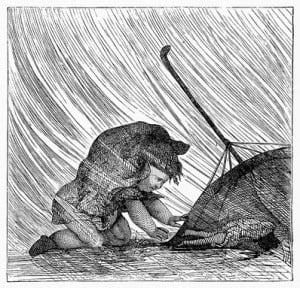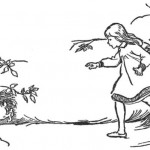When I learned that discipline was not punishment, it was very difficult to reprogram my thinking. My first instinct is still to punish, and though I’ve been doing well in not spanking lately, I am still tempted to do the same thing I always did, just replacing the spanking with some other knee-jerk reactive punishment. I cannot believe what a habit this had become. So while “What do do when you don’t spank” may seem like a silly question, it was a very perplexing one for me.
These are the new ways I’ve discovered discipline in the last 6 months. Pardon me if some of them seem kind of obvious, I’m just trying to be honest about what I’ve learned. Also keep in mind that all my children are under age 4, so my main interest has been in methods that work well for pre-schoolers and toddlers.
Re-direct:
This technique works very well for very young children who cannot understand explanation yet.
Most of the parenting books I used to read, taught against re-direction. They pushed training your child rather than child-proofing your house. I was always under the impression that re-directing your child involved begging and bribing and dragging them away from whatever they were trying to touch.
This is just not true. If your 1 year old toddles through the kitchen and starts to empty the garbage can, you simply take them by the hand and lead them away from the garbage and say “no the garbage is not a toy” (or something to that extent) “but you may play with this car.” You may have to repeat this process a few times, but I have found it to be as effective as when I used to smack hands for the same offense.
It works for your 3 year old too. Example: “No, you may not play with lipstick, but you may use your lip balm.”
Explain:
This was another one that I was poisoned against. Children are subject to you, they don’t deserve an explanation and they wouldn’t understand one to begin with. Hearing no from a parent should be enough reason for them to obey, if you explain yourself to your child, you are groveling.
Again, this is not true. Children are people too, and they can understand alot more than you think. Explaining to your child what is going to happen next is smart. They know what to expect, they are not frightened or angry when playtime is over, because they already knew it was coming. This is also very helpful when used in combination with re-directing.
For example, my 2 year old was recently switched to a bed that she can climb out of. When I put her down for her nap the other day, she promptly got out of bed and opened the door, holding her music box and teddy under her arm. I told her that it was nap-time because she was so tired and needed to rest and walked her back to her bed, gave her a hug and tucked her in. All 4 times it happened. And then (after crying for a moment) she fell sound asleep. Once upon a time, (I can hardly believe this now) I would have spanked her every time she got out of bed, it still would have taken at least 4 times, and she would have been so wired from all that contact and unhappiness that nap-time never would have happened.
I continued to be surprised by how many problems can be averted by simply talking to your children about what is expected and why. Talking to your child is not begging.
Natural consequences:
This is such an easy one. If your child disobeys let them reap the consequences. Its a little hard for parents to allow “bad” things to happen to their children, I suppose we want to protect them from everything sometimes. But how do most of us learn? By trial and error. So, if you tell your 3 year old not to bend the handle of her plastic sand shovel, and she does it anyways, instead of punishment for breaking the toy, you let the fact that her toy is broken be the punishment.
Logical consequences:
Logical consequences are not the direct result of misbehavior like natural consequences are. But they are related to the misbehavior. This will make more sense to an older child, I find that I am able to use it with my oldest rarely. Surprisingly one of the few times my mom used this method still stands out in my mind, I remember lots of punishments, but I rarely remember what it was that I did! This is one of those that I remember what I did.
I was 10, it was the first big snow of the year, my mom had asked us older kids to help our 4 year old sister with her coat and snow pants, but we were in such a hurry to get outside that we made fun of her instead and left her crying on the back porch while we ran to go play in the snow. When my mom found my sister there, she got her ready to go out, and sent us in the house for the rest of the day. My mom played outside with my sister while we watched out the window and wished we had been obedient. I never forgot it!
Time out:
Time out involves putting your child on a chair for time alone. The rule of thumb is one minute per year of their life. It is also very important to use a timer, that way the child knows that you are not just holding them prisoner for an indeterminate amount of time, they will be free when the timer goes off. You have to be careful, because time-outs can be overused in the same way as spankings, but sometimes everyone needs a break from the situation. I’ve found that Time-outs were very helpful in my transitioning out of spanking, while fighting my impulse to spank, it was better to just put the child into time out. I am using them less and less as I get better at other ways of discipline.
Another use for time out involves toys. If a toy is being fought over you can place it in time out (timer and all) and let the children think about how they could play nicely together. (Mine stand there and stare at the toy) When the time is up, they get a second chance to try to co-operate. If they still can’t resolve the issue, then the toy may need to be retired for a time, but I haven’t had to do that yet.
Listen:
When I believed that my children were manipulating me, I never bothered to listen what my children were saying. I remember ignoring Ms. Action as she yelled over and over that she didn’t want to do something and wondering why she wasn’t getting the picture that I wasn’t going to give in. Now I’ve realized that when my children are repeating themselves, many times its because they think I don’t understand them! I’ve found many times the problem is resolved just by recognizing how the child feels. Saying “You don’t want to go to bed, but it’s bedtime now.” tells Ms. Action that I heard her, I understand her, and I am still saying no. My 2 year old doesn’t have a whole lot of words to tell me why she is upset, so if I am willing to say “You want to wear your other shoes? I’m sorry, its too cold today” it can really help her to learn the words to express herself next time, and it can reassure her that I know that she is upset. Sometimes all my children need is to be heard.
Consistency:
I used to think that being consistent meant that you had to punish every time, for every offense. Now I realize that being consistent means you can’t can’t say one thing and do another. When your child asks for candy in the store and you say no, you must stick with that decision even if they cry. If you say no jumping on the couch, that means you can’t let them jump on the couch later when you are tired. You do not have to punish every time, you do not have to use the same punishment. You have to set the boundary’s and limits and stick with them. Only say what you mean, and mean what you say.
I am continuing to read and learn about child discipline. If any of you have something that you have learned about child training, or have a book to reccomend, please share!














